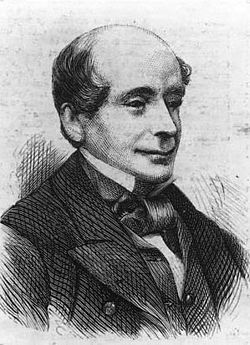James Kay-Shuttleworth
Sir James Kay-Shuttleworth, Bt | |
|---|---|
 Sir James Kay-Shuttleworth, Bt | |
| Born | 20 July 1804 |
| Died | 26 May 1877 (aged 72) |
| Nationality | British |
| Parent | Robert Kay |
Sir James Phillips Kay-Shuttleworth, 1st Baronet (20 July 1804 – 26 May 1877) was a British politician and educationist.
Early life
He was born James Kay at Rochdale, Lancashire, the son of Robert Kay. He was the brother of Joseph Kay and of Sir Edward Ebenezer Kay.[1]
Career
At first engaged in a Rochdale bank, in 1824 he became a medical student at the University of Edinburgh. Settling in Manchester about 1827, he was instrumental in setting up the Manchester Statistical Society. He worked for the Ardwick and Ancoats Dispensary. While still known simply as Dr. James Kay, he wrote The Moral and Physical Condition of the Working Class Employed in the Cotton Manufacture in Manchester (1832), which was cited by Friedrich Engels in Condition of the Working Class in England in 1844. The experience which he thus gained of the conditions of the poor in the Lancashire factory districts, together with his interest in economic science, led to his appointment in 1835 as poor law commissioner in Norfolk and Suffolk and later in the London districts. In 1839 he was appointed first secretary of the committee formed by the Privy Council to administer the Government grant for the public education in Britain.[2]
In 1840, he founded with E. Carleton Tufnell, the Battersea Normal College for the training of teachers of pauper children.[3] This became the College of St Mark and St John at Battersea, London and later the University College Plymouth St Mark & St John. In 2012 it obtained full university status as the University of St Mark & St John. The original college was the first training college for school teachers; today's system of national school education, with public inspection, trained teachers and its support by state as well as local funds, is largely due to the original founders initiative.[1]
Later life

A breakdown in his health led him to resign his post on the committee in 1849, but subsequent recovery enabled him to take an active part in the working of the central relief committee instituted under Lord Derby, during the Lancashire cotton famine of 1861–1865. He was created a baronet of Gawthorpe Hall in the County Palatine of Lancaster in 1849.[4] Until the end of his life he interested himself in the movements of the Liberal Party in Lancashire, and the progress of education. His Physiology, Pathology and Treatment of Asphyxia became a standard textbook, and he also wrote numerous papers on public education. He was also one of the key figures in the foundation of the Girls' Public Day School Company and was a member of their council until shortly before his death. He was High Sheriff of Lancashire for 1864. He died in 1877 in London and is buried in Brompton Cemetery, London.[1]
Personal life
In 1842 he married Janet Shuttleworth (b. 9 November 1817), assuming by royal licence his bride's name and arms. His wife had inherited the estate centred on Gawthorpe Hall in Padiham at aged four months.[1]
They had five children. His son, Sir Ughtred James Kay-Shuttleworth (1844–1939), the eldest, became a well-known Liberal politician, sitting in parliament for Hastings from 1869 to 1880 and for the Clitheroe division of Lancashire from 1885 till 1902, when he was created Baron Shuttleworth. He was Chancellor of the Duchy of Lancaster in 1886, and secretary to the Admiralty in 1892–95.
References
- Engels, Friedrich; McLellan, David (1999). The Condition of the Working Class in England. New York: Oxford University Press. ISBN 0-19-283688-9.
- This article incorporates text from a publication now in the public domain: Chisholm, Hugh, ed. (1911). Encyclopædia Britannica (11th ed.). Cambridge University Press.
{{cite encyclopedia}}: Missing or empty|title=(help)
- ^ a b c d Selleck, R. J. W. "Shuttleworth, Sir James Phillips Kay-, first baronet (1804–1877)". Oxford Dictionary of National Biography (online ed.). Oxford University Press. doi:10.1093/ref:odnb/15199.
{{cite encyclopedia}}: Unknown parameter|accessed=ignored (help) (Subscription or UK public library membership required.) - ^ Stephens, W. B. (1985). "Minutes and reports of the Committee of Council on Education, 1839–1899" (PDF). Microform Academic Publishers. Retrieved 30 August 2014.
- ^ Corrigan, P. R. D. (January 2008). "Tufnell, Edward Carleton (1806–1886)". Oxford Dictionary of National Biography (online ed.). Oxford University Press. doi:10.1093/ref:odnb/48877.
{{cite encyclopedia}}: Unknown parameter|accessed=ignored (help) (Subscription or UK public library membership required.) - ^ "No. 21053". The London Gazette. 25 December 1849.
Further reading
- Charles William Sutton (1892). . In Lee, Sidney (ed.). Dictionary of National Biography. Vol. 30. London: Smith, Elder & Co.
- Mort, Frank (2002). Dangerous Sexualities: Medico-Moral Politics in England Since 1830 (2nd ed.). Routledge. ISBN 978-0-203-44756-7.
- Platt, Harold L. (2005). Shock Cities: The Environmental Transformation and Reform of Manchester and Chicago. University of Chicago Press. ISBN 978-0-226-67076-8.
External Resources
- James Kay-Shuttleworth Papers at the John Rylands Library, Manchester.
- Use dmy dates from July 2012
- 1804 births
- 1877 deaths
- People from Rochdale
- English educational theorists
- Baronets in the Baronetage of the United Kingdom
- High Sheriffs of Lancashire
- Burials at Brompton Cemetery
- People associated with the Girls' Day School Trust
- Permanent Secretaries of the Education Office
- 19th-century English medical doctors
